SCIENCE MEETS INDUSTRY
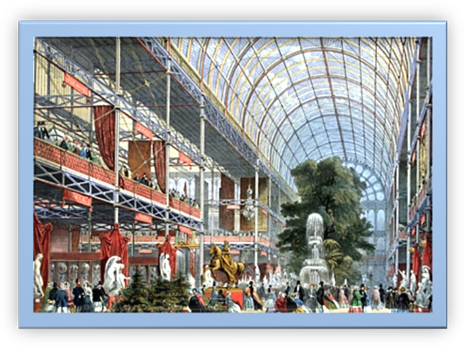
Exhibition Hall at the Crystal Palace in London
Unit
Overview
While
the effects of the Scientific Revolution and the Enlightenment opened a new
political era, people also were experiencing rapid changes in their economic and
social lives. The Industrial
Revolution, which began in Great Britain, spread to the European continent and
the rest of the world as the nineteenth century unfolded. Generally speaking, the Industrial Revolution
began in the late eighteenth century and continued throughout the nineteenth
century. It was a prime example of a
series of developments that took place while other events were unfolding on the
world stage. Let’s see how it all happened.

STOP: Answer Section A Questions
Not
the Same Old Family Farm
Before
industry took center stage, however, the continuation of the Scientific
Revolution transformed agriculture in Great Britain. With remarkable results, changes in farming
during the early 1700’s altered techniques and methods that had been practiced
since the Middle Ages. Through a policy known as enclosure, wealthy British landowners bought and fenced village
lands. In order to make this a
profitable venture, they began to look for ways to increase their
harvests. Fertile soil was a necessary
component for higher yields, and scientific farmers soon found new procedures
to assure its conservation.
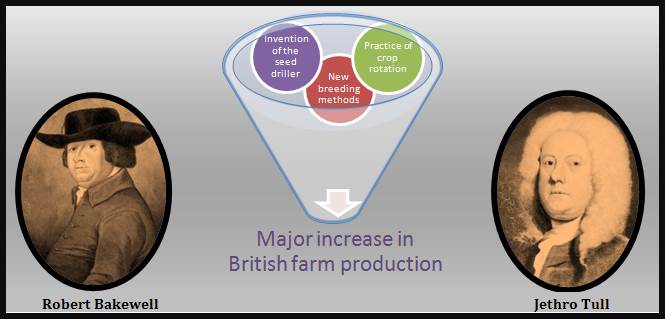
For
centuries, the chief method for this had been to let one-third of the property
lie fallow every three years. This meant one-third of Great Britain’s farm
land was out of production every year.
Viscount Charles Townsend remedied the situation by promoting crop rotation,
a system which alternated the plants which were grown annually. This renewed the soil without any loss of
production. The invention of the seed
drill by Jethro Tull in 1721
replaced sowing seeds by hand and allowed farm workers to plant in well-spaced
rows at exact depths. Scientific
research by Robert Bakewell resulted
in improved breeding methods, and livestock owners began raising larger animals
which also increased the food supply. By
1870, British farmers were producing 300% more food than they were in 1700, but
British industries made extraordinary advances as well.
STOP:
Answer Section B Questions
Why
Britain?
Even
though Great Britain was not the largest country in Europe in 1700, it did have
certain qualities that made it a prime candidate for industrial growth. The country possessed three natural resources
essential to the new machinery of the age:
water, iron and coal. Geography also favored the industrial
development in Great Britain. As an
island nation, it possessed many excellent harbors and a fleet of merchant
ships ready to access new markets. These
ships were owned by wealthy merchants with money to invest in new
projects. British businessmen not only
provided necessary financial backing but also had an interest in science and
new technology. Great Britain housed
Europe’s soundest banking system and provided loans to worthy inventors. Although the British participated in many
wars during the eighteenth century, none were fought on their own soil. Therefore, businesses in Great Britain did
not have to repair the damages caused by an enemy invasion.

Great
Britain’s increasing food supply also helped to promote industrial growth. As a result, health conditions improved, and
the annual death rates began to decline.
Since the birth rates remained steady throughout the 1700’s, the number
of people grew rapidly, and the populace doubled in just one hundred
years. This population explosion gave
industrialists a ready supply of labor for the new factories. The increase in agricultural production
caused prices for food to decline so British citizens had more money to spend
on consumer goods such as clothes and shoes.
Parliament, the British
law-making body, included a large number of merchants and businessmen who
supported laws favoring new investments and trade. All of these factors, combined with Great Britain’s
stable government, created favorable conditions for major industrial growth.
STOP: Answer Section C Questions
One
Thing Led to Another
The
changes that snowballed to become the Industrial Revolution began in Great
Britain’s textile industry. Before industrialization, all cloth was
produced by spinners and weavers who worked in their own homes. As a work force consisting mainly of women,
they made wool and linen fabrics, but cotton soon became much more
desirable. It was light, durable and
easy to maintain. Spinners and weavers
were not able to make as much cotton cloth as people wanted to buy. Merchants realized greater profits were
possible if they could find a way to speed up the process.

First
John McKay invented the flying shuttle in 1733, and weavers
were able to double the amount of cloth that they produced. Shortly, spinners were unable to supply
enough thread for the weavers to continue this level of production. John
Hargreaves designed the spinning
jenny to help solve this problem.
One spinner could then form six or eight spools of thread at once. Even bigger changes soon followed. The water
frame, engineered by Richard Arkwright and the spinning mule,
invented by Samuel Compton, used water from fast-flowing
streams to drive the spinning wheels.
Although these machines were capable of producing fine-quality thread,
they were much too big to be housed in small, English cottages. It became more practical to set up several
large machines in buildings called factories.
The
new factories operated with water power, and owners were forced to build them
next to rivers and streams. These
locations often did not provide convenient access to workers, raw materials and
markets. Manufacturers began to search
for new sources of power. Coal mines
were using pumps driven by steam to remove water from shafts, but the engines
developed for this purpose were expensive to operate. James
Watt, an instrument maker from Scotland, acquired financial backing and
began to improve the steam engine. The
result was an efficient, practical power source that could be used anywhere.
STOP: Answer Section D Questions.
Getting
from Here to There
As
production rose, the British industrialists were faced with a new
challenge. How were they going to move
raw materials to their factories and products to their markets? When the Industrial Revolution began, roads
in Great Britain could not handle heavy wagons and were inaccessible in bad
weather. John McAdam, a Scottish engineer, designed a new plan for their
construction by adding a layer of large stones for drainage and by topping it
with an additional section of crushed rock.
Although this was a major improvement, transporting goods by water was
still cheaper. To cut costs even
further, the British built an expanded network of canals that extended water
transportation to even more areas.
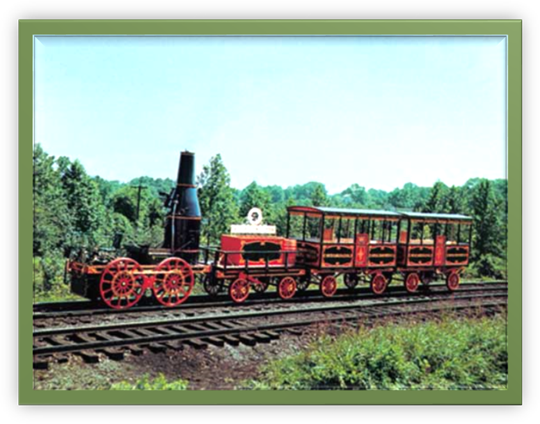
An Early Steam Locomotive
However,
steam power soon revolutionized transportation as well as production. In 1804, an English engineer, Richard Trevithick, made an engine that
could pull a cart on a set of rails, and the locomotive was born. Many versions soon followed, and George Stephenson began working on the
world’s first railroad line in northern England. By 1805, trains were carrying coal from the
mines of Yorkshire to the ports of the North Sea along twenty-seven miles of
track. Those who built railroad lines
recognized the advantage of carrying passengers as well as freight. Although they were slow by our modern
standards and broke down frequently, trains were an immediate success. For example, in 1750, it took two weeks to
travel in a carriage from London to Edinburgh.
By 1830, the same 330 mile trip by rail was completed in three days.
The
development of a railway system brought about dramatic changes in British
life. Building bridges and tunnels for
trains resulted in the creation of millions of new jobs. The increased demand for coal and iron
elevated the demand for workers in these areas, too. Many employees were also willing to relocate
since they could easily make regular visits home. Travel for pleasure also became popular, and
seaside resorts gained in popularity.
Those who remained on the farm also profited since progress in
transportation offered new opportunities to expand the markets for meat and
produce.
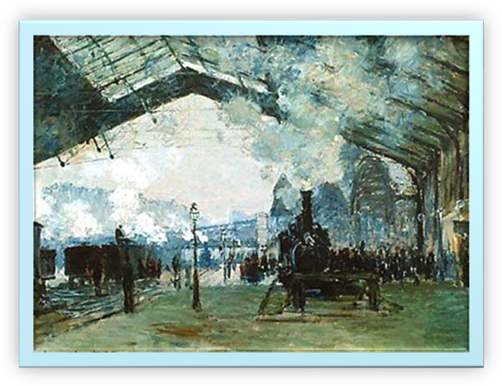
Arrival of the Normandy Train by Artist Claude Monet
Although
they were a great benefit, trains were far from perfect, and some enterprises
suffered as a result of their expansion.
Many canal operators, for instance, found themselves out of business as
the railroads advanced. Delays and
accidents were common occurrences, and travelers often found themselves covered
in black soot. However, railroads still
proved to be faster and more reliable than the methods of transportation used
in the past. Trains connected factories
to suppliers of raw materials and buyers of finished goods. This enabled the Industrial Revolution to continue
it meteoric growth.
STOP: Answer Section E Questions
The
Spread of Industrialization
No
other country came close to rivaling Great Britain as the undisputed industrial
leader of the age. By 1850, Britain was
producing two-thirds of the world’s coal and one-half of the world’s cotton
cloth. The nation was determined to keep
its edge. For many years, it was illegal
for engineers to leave the country, but their departure proved impossible to
control. Samuel Slater donned a disguise and boarded a ship bound for
America where he built machines from memory.
Other ambitious workers made their way to the European continent and
pockets of industry grew. Belgium, with its supply of coal and
navigable rivers, was one of the first countries to open factories powered by
steam.
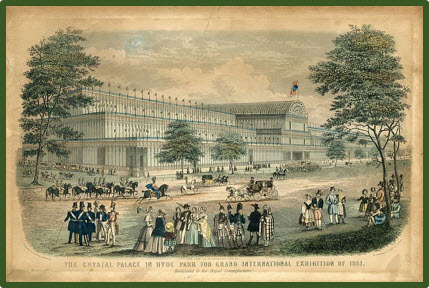
Postcard Featuring the Crystal
Palace
Britain’s
unprecedented leadership was obvious in 1851 when the Great Exhibition opened in London’s Crystal Palace. Designed
especially for this event, the iron and glass structure showcased the wonders
of the industrial age. Over six million
visitors watched printing presses turn out thousands of copies in an hour and
cheered a locomotive traveling at sixty miles per hour. Exhibits, including stuffed elephants from
India and fine porcelain from China, demonstrated the far-reaching extent of
the British Empire and the possibilities for the future.
Going
Global
By
the mid-nineteenth century, advancements in transportation and communication
moved beyond Great Britain and onto the world stage. Railroads permeated almost every continent,
and steamships were improving rapidly.
For example, the Transcontinental
Railroad in the United States was completed and carried passengers from New
York to San Francisco in less than a week.
The Suez Canal, which
connected the Mediterranean and Red Seas, opened in 1869 after a decade of
construction. Ships no longer had to
journey around Africa to reach India, and this cut one month off the trip. Communication underwent dramatic changes as
well. By 1850, telegraph lines connected all the major cities in the United
States. The following year, a telegraph
cable was laid under the English Channel creating a connection between Paris
and London.

Financing
railroad and telegraph lines required large amounts of money for investing
known as capital. To raise money, business owners sold shares
of stock in their companies. Everyone who bought stock became an owner in
the company. Stockholders shared the
company’s profits when the business did well and often sold their shares for
more money than they paid for them. Of
course, if the company did poorly, stockholders risked losing their entire
investment. Businesses that functioned
this way became known as corporations
and operated on a greater scale than ever before. These new financial connections and a massive
increase in trade continued to tie the countries of the world together.
STOP: Answer Section F Questions
What
Does It All Mean?
The
Scientific Revolution and the Enlightenment inspired more than theoretical and
philosophical changes. They stimulated a
series of rapid changes in industry, transportation and communication that
continue to affect the manner in which we live and work. The spread of industrialism caused people to
respond in a variety of ways, and not everyone agreed on how profits should be
distributed. New methods of doing business
and accumulating wealth motivated countries to adopt a new world view. However, several negative byproducts of
industrial growth also began to emerge.
The quest for greater earnings caused factory owners to neglect the
health and safety of their workers in order to maintain their competitive
edge. Urban growth and a massive influx
of workers from the countryside resulted in overcrowded conditions in the
poorly prepared cities. Disease and
crime were all too common in these settings.
What obligations did businesses have to their workers? What was the role of government in all of
this? How were businessmen going to
continue to increase their profits? We
are still searching for the answers to these questions created by the
Industrial Revolution.
Additional Resources and Activities

When Everything Changed: The Industrial Revolution Article and Quiz